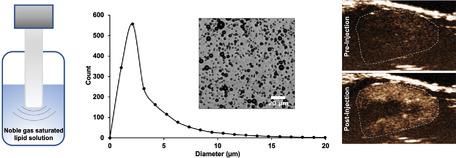当前位置:
X-MOL 学术
›
Adv. Healthcare Mater.
›
论文详情
Our official English website, www.x-mol.net, welcomes your
feedback! (Note: you will need to create a separate account there.)
Ultrasound Responsive Noble Gas Microbubbles for Applications in Image-Guided Gas Delivery.
Advanced Healthcare Materials ( IF 10.0 ) Pub Date : 2020-03-24 , DOI: 10.1002/adhm.201901721 Rajarshi Chattaraj 1 , Misun Hwang 2, 3 , Serge D Zemerov 4 , Ivan J Dmochowski 4 , Daniel A Hammer 1, 5 , Daeyeon Lee 1 , Chandra M Sehgal 3
Advanced Healthcare Materials ( IF 10.0 ) Pub Date : 2020-03-24 , DOI: 10.1002/adhm.201901721 Rajarshi Chattaraj 1 , Misun Hwang 2, 3 , Serge D Zemerov 4 , Ivan J Dmochowski 4 , Daniel A Hammer 1, 5 , Daeyeon Lee 1 , Chandra M Sehgal 3
Affiliation

|
Noble gases, especially xenon (Xe), have been shown to have antiapoptotic effects in treating hypoxia ischemia related injuries. Currently, in vivo gas delivery is systemic and performed through inhalation, leading to reduced efficacy at the injury site. This report provides a first demonstration of the encapsulation of pure Xe, Ar, or He in phospholipid-coated sub-10 µm microbubbles, without the necessity of stabilizing perfluorocarbon additives. Optimization of shell compositions and preparation techniques show that distearoylphosphatidylcholine (DSPC) with DSPE-PEG5000 can produce stable microbubbles upon shaking, while dibehenoylphosphatidylcholine (DBPC) blended with either DSPE-PEG2000 or DSPE-PEG5000 produces a high yield of microbubbles via a sonication/centrifugation method. Xe and Ar concentrations released into the microbubble suspension headspace are measured using GC-MS, while Xe released directly in solution is detected by the fluorescence quenching of a Xe-sensitive cryptophane molecule. Bubble production is found to be amenable to scale-up while maintaining their size distribution and stability. Excellent ultrasound contrast is observed in a phantom for several minutes under physiological conditions, while an intravenous administration of a bolus of pure Xe microbubbles provides significant contrast in a mouse in pre- and post-lung settings (heart and kidney, respectively), paving the way for image-guided, localized gas delivery for theranostic applications.
中文翻译:

用于图像引导气体输送应用的超声响应惰性气体微泡。
稀有气体,尤其是氙 (Xe),已被证明在治疗缺氧缺血相关损伤中具有抗细胞凋亡作用。目前,体内气体输送是全身性的并通过吸入进行,导致损伤部位的功效降低。该报告首次演示了将纯 Xe、Ar 或 He 封装在磷脂涂层的亚 10 µm 微泡中,而无需稳定的全氟化碳添加剂。壳成分和制备技术的优化表明,二硬脂酰磷脂酰胆碱 (DSPC) 与 DSPE-PEG5000 在摇动时可产生稳定的微泡,而二山萮酰磷脂酰胆碱 (DBPC) 与 DSPE-PEG2000 或 DSPE-PEG5000 混合可通过超声/离心产生高产率的微泡方法。使用 GC-MS 测量释放到微泡悬浮液顶部空间中的 Xe 和 Ar 浓度,而直接释放到溶液中的 Xe 通过 Xe 敏感的 Cryptophane 分子的荧光猝灭来检测。人们发现气泡生产可以扩大规模,同时保持其尺寸分布和稳定性。在生理条件下,在体模中观察几分钟即可观察到出色的超声对比度,而静脉注射一团纯 Xe 微泡可在小鼠肺前和肺后环境(分别为心脏和肾脏)中提供显着的对比度,从而为小鼠用于治疗诊断应用的图像引导、局部气体输送的方式。
更新日期:2020-03-24
中文翻译:

用于图像引导气体输送应用的超声响应惰性气体微泡。
稀有气体,尤其是氙 (Xe),已被证明在治疗缺氧缺血相关损伤中具有抗细胞凋亡作用。目前,体内气体输送是全身性的并通过吸入进行,导致损伤部位的功效降低。该报告首次演示了将纯 Xe、Ar 或 He 封装在磷脂涂层的亚 10 µm 微泡中,而无需稳定的全氟化碳添加剂。壳成分和制备技术的优化表明,二硬脂酰磷脂酰胆碱 (DSPC) 与 DSPE-PEG5000 在摇动时可产生稳定的微泡,而二山萮酰磷脂酰胆碱 (DBPC) 与 DSPE-PEG2000 或 DSPE-PEG5000 混合可通过超声/离心产生高产率的微泡方法。使用 GC-MS 测量释放到微泡悬浮液顶部空间中的 Xe 和 Ar 浓度,而直接释放到溶液中的 Xe 通过 Xe 敏感的 Cryptophane 分子的荧光猝灭来检测。人们发现气泡生产可以扩大规模,同时保持其尺寸分布和稳定性。在生理条件下,在体模中观察几分钟即可观察到出色的超声对比度,而静脉注射一团纯 Xe 微泡可在小鼠肺前和肺后环境(分别为心脏和肾脏)中提供显着的对比度,从而为小鼠用于治疗诊断应用的图像引导、局部气体输送的方式。











































 京公网安备 11010802027423号
京公网安备 11010802027423号